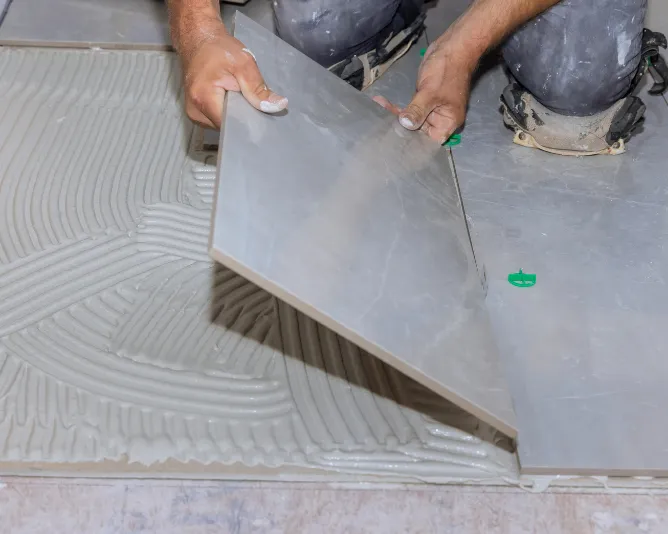Before you ruin your flooring project, discover why using wall tile adhesive on floors could be your biggest DIY mistake yet.
Introduction
When planning a tiling project, the choice of adhesive might seem like a minor detail, but it can make the difference between a lasting installation and a costly disaster. With the rising costs of home improvement materials – up 23% since 2021 – many DIY enthusiasts are tempted to cut corners by using wall tile adhesive for floor installations. This seemingly simple substitution can lead to serious consequences that could compromise both the aesthetic appeal and structural integrity of your flooring. Understanding the crucial differences between wall and floor adhesives isn’t just about technical specifications – it’s about protecting your investment and ensuring the safety of your home.
Understanding Tile Adhesives
Wall and floor adhesives are fundamentally different products engineered for specific purposes. Wall tile adhesives are formulated with properties that excel in vertical applications, featuring:
- Higher initial grab strength for immediate hold
- Thinner consistency for easier vertical application
- Limited load-bearing capacity
- Reduced flexibility once cured
In contrast, floor adhesives are specifically designed with:
- Enhanced structural strength for weight distribution
- Higher flexibility to accommodate movement
- Superior moisture resistance
- Increased bond strength for horizontal pressure
The Science Behind Floor Adhesives
The engineering behind floor adhesives is rooted in complex physical demands. Floor tiles must withstand significant forces, including: vertical compression from foot traffic (up to 150 pounds per square foot), lateral forces from movement, and varying temperature conditions. Modern floor adhesives are formulated with polymer-modified compounds that create a robust crystalline structure when cured. This molecular arrangement allows the adhesive to distribute weight evenly across the substrate while maintaining flexibility under stress. According to recent industry studies, properly installed floor adhesives can maintain their structural integrity for over 25 years under normal conditions.
Risks of Using Wall Adhesive on Floors
Using wall adhesive for floor installations presents several immediate and long-term risks:
- Structural Failure: Wall adhesives lack the necessary strength to support constant foot traffic
- Tile Displacement: Reduced bond strength can lead to loose or shifting tiles
- Moisture Damage: Inadequate water resistance may cause adhesive breakdown
- Cracking: Limited flexibility results in stress fractures
- Safety Hazards: Loose tiles create trip hazards and sharp edges
Industry data shows that improper adhesive use accounts for 37% of all tile installation failures, leading to costly repairs and potential liability issues.
Technical Requirements for Floor Adhesives
Floor tile adhesives must meet specific technical standards to ensure safety and durability:
PEI Ratings (Porcelain Enamel Institute):
- Class 1: Light traffic (wall use only)
- Class 2: Light to moderate traffic
- Class 3: Moderate to heavy residential traffic
- Class 4: Heavy commercial traffic
- Class 5: Extra heavy commercial traffic
Coefficient of Friction (COF) Standards:
- Minimum 0.5 COF for level surfaces
- Minimum 0.6 COF for inclined surfaces
- Minimum 0.7 COF for wet areas
Proper Floor Tile Installation
Successful floor tile installation requires careful attention to detail and the right materials. Professional tilers report that 82% of installation success depends on proper adhesive selection and application. Key considerations include:
- Substrate Preparation: Ensure clean, level, and properly cured surface
- Environmental Conditions: Maintain recommended temperature and humidity levels
- Application Technique: Use correct trowel size and pattern
- Curing Time: Allow full curing before exposing to traffic
Cost Analysis
While using wall adhesive might seem cost-effective initially, the long-term financial implications can be severe:
Initial Costs (Per 100 sq ft):
- Wall Adhesive: $45-65
- Floor Adhesive: $75-95
- Professional Installation: $350-500
Potential Repair Costs:
- Tile Replacement: $200-400
- Substrate Repair: $300-600
- Complete Reinstallation: $800-1,200
Conclusion
The evidence is clear: using wall tile adhesive on floors is a risky proposition that can lead to significant problems and expenses. While the initial cost savings might be tempting, the potential for failure and the associated repair costs far outweigh any short-term benefits. Professional installers unanimously recommend using appropriate floor-grade adhesives for all floor tile installations. By investing in the right materials and following proper installation procedures, you can ensure a durable, safe, and beautiful tiled floor that will last for years to come.
Expert Tips
Watch for these warning signs of incorrect adhesive use:
- Hollow sounds when tapped
- Movement or rocking when stepped on
- Cracking or lifting at corners
- Grout line separation
Consult a professional if:
- The project exceeds 100 square feet
- The substrate shows signs of damage
- Special patterns or materials are involved
- Water exposure is a concern
For additional resources and expert guidance, consult:
- Tile Council of North America (TCNA)
- National Tile Contractors Association (NTCA)
- Local certified tile installers
- Manufacturer installation guides
FAQ
Do you have to remove old wall tile adhesive before tiling?
Removing old adhesive is an essential part to replacing any tile. However, it’s important to use the right tool to prevent damaging other existing tiles.
What is the best tile glue for floors?
From floors to walls to ceilings—and anywhere else—epoxy will do the job. Epoxy provides an even stronger bond than thinset and mastic, and is completely impervious to moisture, water, and most chemicals. Epoxy also doesn’t require a latex additive to protect it from cracking as some thinset does.
Can you use peel and stick wall tiles on floor?
Peel and stick tile is exactly what it sounds like – tile that has an adhesive backing which can be used for walls, floors and backsplashes. It comes in a variety of materials like wood, glass and metal, and it’s easier to install than traditional tile, making it a great DIY option.
What happens if you use wall adhesive on floor tiles?
Unlike floor tile adhesives, you can only use wall tile adhesives for holding tiles on a vertical surface. The floor tile adhesive is strong and can withstand horizontal pressure as people move.
Can tile adhesive be used on floor?
Floor tile adhesive is engineered to handle the demands of horizontal surfaces, such as floors. Whether upgrading your living room or renovating your kitchen floor, this adhesive provides the stability and durability needed.
Sources
[1] https://www.youtube.com/watch?v=-pHBZmO5qA8
[2] https://www.atlasceramics.co.uk/can-wall-tiles-used-floor/
[3] https://www.gresbondbykajaria.com/blog/what-is-the-difference-between-wall-and-floor-tile-adhesives.php



